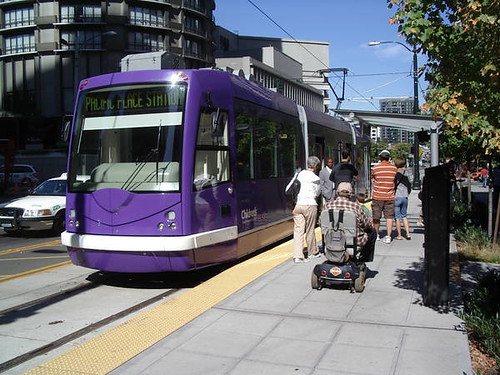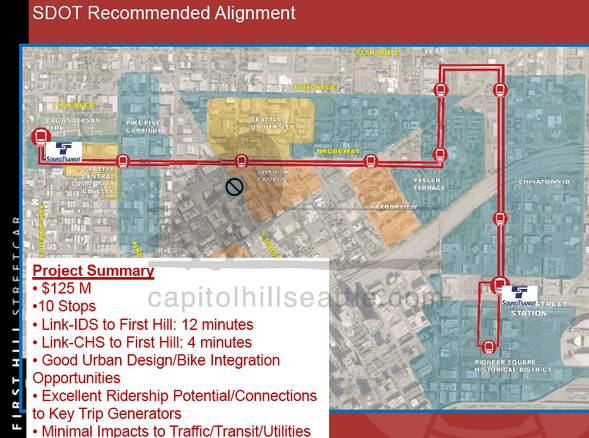
Someday, the soon-to-start-construction First Hill streetcar might connect with the South Lake Union line thanks to a Federal grant awarded to the City of Seattle on Tuesday to study the feasibility of linking the two routes through downtown.
And then, of course, you can say the FST connects with the SLUT.
The city’s announcement of the grant focused on the study the $900,000 will fund:
The study will examine the benefits, costs, and impacts of implementing an urban circulator in the corridor between the Lower Queen Anne, Uptown, and South Lake Union neighborhoods to the north, and the King Street Station and International District Multimodal Hub on the south end of downtown. The selected alignment will have the potential to connect all three of Seattle’s multimodal transportation hubs, King Street and International District Stations, Colman Dock, and Westlake Center.
The First Hill route is fully planned and paid for and ready to start laying rail in 2012 but the Seattle Department of Transportation continues to look at the possibility of extending the route north on Broadway to Roy and will study the feasibility of that plan if funding becomes available. The Capitol Hill Chamber of Commerce recently endorsed Proposition 1 citing the potential that it would help make money available for the extension and to connect the First Hill route to other lines in the city. We’re checking into how the newly announced Federal Transportation Administration grant will impact planning for the north Broadway extension.
Seattle Transit Blog reports that the $900k grant was part of $49 million in transportation funding awarded to Washington.
Below is the full announcement from City Hall:
The Federal Transit Administration today announced the City of Seattle has won a $900,000 grant to study a high capacity transit project, such as a rapid streetcar, through the heart of downtown Seattle. The project would connect existing and proposed high-density neighborhoods to one another and the regional transit system. The current Seattle Transit Master Plan shows that a rail system on this corridor could generate approximately 10,000 new transit riders in Seattle Center City by 2030.
“The federal government took a close look at our proposal and believes the project is a good investment in moving people quickly and reliably through downtown and to our neighborhoods,” said Seattle Mayor Mike McGinn. “Combined with rail planning money I have proposed in the 2012 budget and funding from other sources, this brings us closer to expanding our streetcar network and giving people better transportation choices.”
“I’m pleased that Seattle has been selected to receive this grant to help the city plan responsibly for its future high-capacity transit needs,” said Congressman Jim McDermott. “This will put Seattle in a better position to compete for transit dollars, and the family-wage construction jobs that will come with them when Congress passes the American Jobs Act. I take great pride in being able to support continued investment in critically needed projects like these that plan, maintain and improve our city’s transportation systems.”
The study will examine the benefits, costs, and impacts of implementing an urban circulator in the corridor between the Lower Queen Anne, Uptown, and South Lake Union neighborhoods to the north, and the King Street Station and International District Multimodal Hub on the south end of downtown. The selected alignment will have the potential to connect all three of Seattle’s multimodal transportation hubs, King Street and International District Stations, Colman Dock, and Westlake Center.
Mayor McGinn’s 2012 proposed budget also invests $1.5 million to start planning to connect Seattle’s neighborhoods with high capacity transit, including rail. The federal grant would augment this funding and help move plans for the downtown connector closer to completion.




This is really good news, and is another reason to vote against the ballot initiative to add another $60 car tab fee to the already passed $40 fee earlier this year. Why can’t some of the $900,000 be used to study the extension of the First Hill streetcar to Aloha St? It shouldn’t cost that much to study the feasibility of this needed extension.
Aside from the fact that’s not what the Feds gave the city the money for, it’s in no way a reason to oppose Proposition 1.
Prop 1 will give us new sidewalks, significant enhancements to our existing bus service, road maintenance and repair, and bicycle facilities. All good reasons to vote yes.
Yes: Any money to help plan projects to connect our disjointed systems is money well spent! Of course it drives me crazy that all this money goes into planning, rather than actual implementation, but it’s a good first step.
Yes: Keep up the support for the Northern extension of the Broadway/First Hill streetcar. It is ridiculous to even consider leaving the dense Northern Broadway business sector out of this transit plan.
Yes: Vote YES for Proposition 1. It’s a win for transit, roads and pedestrians/cyclists. I understand it raises the cost of owning a car, but everyone is contributing to taxes to build/maintain roads, so why shouldn’t car owners, the ones who use the roads the most, contribute a bit more to their upkeep AND to funding transit projects that will help decongest our roadways? Call me crazy, but I think it’s fair.
Yeah, how does this have anything to do with the car tab fees? Vote yes on Prop 1!
Implementing something without a plan is a good idea to you?
Vehicle owners already pay alot more for maintenance of our roadways than auto-less people, via the gas tax, so please do not claim otherwise.
Proposition 1 is very unbalanced in favor of transit (Do we really need all those new “parking spaces for bikes”?….most of the ones we have are already underutilized. And the City has already spent millions on new bike lanes, useless “sharrows” and the like). I agree that the First Hill Streetcar should be extended to Aloha St, but I’m not going to vote for Prop 1 just because of this.
Calhoun,
As the city’s website explains:
“The City of Seattle pays for work on streets, bridges, and other parts of the transportation system with from a variety of sources. They include federal and state grants, (gas tax revenues), local fees, and the City’s General Fund. Federal and state grants must be matched with local funds.”
Even if you are only saying that the majority of Seattle transportation infrastructure funding comes from fuel-taxes, this seems at odds with, for example, the “Bridging the Gap” levy which is mostly funded by a voter approved property tax.
And in regard to the matching federal funds, they are not being met entirely by fuel-tax revenues either, as a recent CBO study explains:
“From 2005 to 2009, every state received more funding for highway programs than they contributed to the Highway Account of the Highway Trust Fund. This was possible because more funding was authorized and apportioned than was collected from the states, and the fund was augmented with about $30 billion in general revenues since fiscal year 2008.”
And the claim that Prop-1 is “…very unbalanced in favor of transit…” seems to miss the forest for the trees. It is a “transit” proposition. And then to claim that somehow it will be spent disproportionately on bicycle parking is disingenuous at best.
You do realize that the majority of Prop-1 funding goes to the “Transit Master Plan Bus Corridor Speed and Reliability Improvements” and the second greatest recipient of funds is for “Pavement Preservation and Traffic Safety”?
In fact, “Pavement Preservation” is the largest line-item expense at an estimated $40-million over the ten year period. Does this not serve you and all other auto-peoples?
In 2009, the gas tax only covered 4% of the Seattle Department of Transportation budget.
Everyone is paying their fare share regardless of whether they own/drive an automobile.
The main reason why this money can’t be used to study the Aloha Street extension of the First Hill Streetcar is because that line has already been studied and designed – Sound Transit just doesn’t have the money to build it. From what I understand, Prop 1 could provide some of that missing construction money.